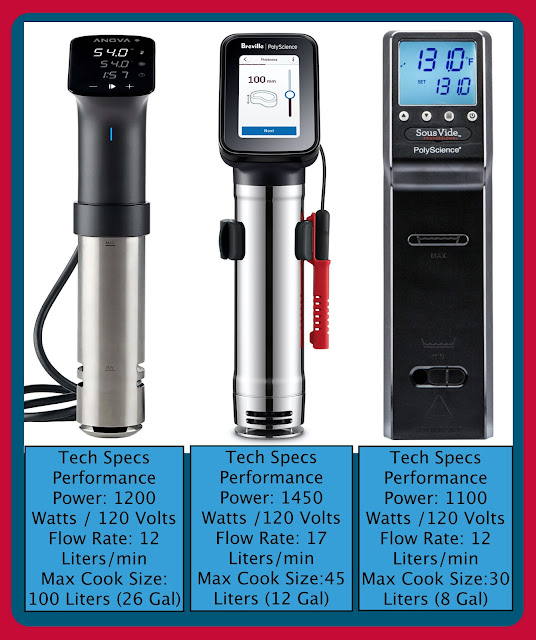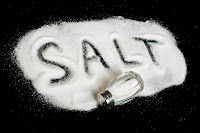Is the Anova-Pro Over-Spec'd?
The Immersion Circulator was purchased for one purpose: to examine the specifications. Most units top out at about 8-10 Gallons (30-38-Liters) which made me wonder if Anova's claim could be valid based on the specs as listed.
I also have the Breville (Hydro-Pro-Plus) rated for 12-Gallons 45-Liters) and found through testing that its specs are accurate. It's also my contention that Breville could have been Spec'd higher, but I think the company erred on the side of caution. I am confident that Breville arrived at their calculations using a meticulous process. If you would like to read my review on the Breville, where I compared a 64l to an 18l container using lots of math, it can be found HERE.
The other unit I have is the Polyscience-ChefSeries unit rated at 30-Liters. This was the first I.C I purchased. I started exploring Sous-Vide back in 2006 but never got really serious until Dr. Baldwin published his work, and I bought the Polyscience-Chef Series. I dabbled with PID Controllers and Crockpots back in the day, but this was a far cry from what I do today.
Anyhow for me, it's tough to believe that the Anova Pro specs, which pale in comparison to the Breville, can heat and circulate 100-Liters of Water.
It begs the question: how do manufacturers come up with the specifications? To my knowledge, they consider Wattage and Flow Rate and, most importantly, Safety. The unit has to safely and efficiently circulate the Water around many proteins and consider the time necessary to recover after adding proteins. I.e., Hypothetically, let's say the I.C is set to 150f, and after dropping cold meat, it falls to 145f. How long will it take to get back up to 150f? Can you imagine it falling more?
The cooking method of Sous-Vide is all about precision and timing, and if something has been over Spec'd, this could pose a safety concern.
The Hydro-Pro-Plus By Breville is Spec'd at a Max Capacity of 45-Liters of Water, 1450 Watts, and a Flow Rate of 17-Liters a Minute.
The Anova Pro is Spec'd at a Max Water Capacity of 100-Liters of Water, 1200 Watts, and has a Flow Rate of 12-Liters a Minute.
The Breville's Wattage is 17% more powerful, and the Flow Rate is 30% better than the Anova-Pro, but the Anova-Pro handles 55-More Liters of Water than the Hydro-Pro?
To be clear, I am not knocking on the Anova Pro, and I just want to get to the bottom of what I think is a significant miscalculation on the specs. I still have the original Anova, my second unit, after buying the Polysceince-ChefSeries unit many years ago. Note: I have 8 I.C's.
Also, I think it's important to note that I started writing this post before starting any tests. In the end, if I am wrong, I will admit it and give accolades where they are due.
I went down this Rabbit hole after reading a post about a guy wanting to process a 22 lb Rib-Roast. The post had over 150 comments which included the claims by Anova that it could circulate 100-Liters of Water. Many suggested he use two Immersion Circulators to be on the safe side. Out of curiosity, I made several inquires about the diameter, but he never responded. I am sure the poster was super excited about posting this massive cool looking Rib-Roast only for us to turn his post into an inquisition.

Just about everyone brought up the specifications of the Anova Pro and how it could circulate 100-Liters of Water. In fact, it was not until someone posted this glib off the Anova Website that made me wanted to buy the Anova Pro just to test their claims.
I asserted some opinions in the thread, but they were only anecdotal. I don't even own one, so how can I argue that the specs are flawed? So now that I own one, I am speculating that the Anova Pro is over Spec'd based on my vast knowledge of I.C's.
I decided to use my Polycarbonate 84-Liter Container with custom lids to match the units.
I will compare the Anova-Pro, Breville, and Chef series.
The 84-Liter Container will be filled with 70-Litres of Water and be allowed to equalize to the ambient temps of the house overnight, which is 65f. I will use the 3-Thermoworks Temp Probes and the internal probes of the units to monitor the temps.
First Test is to see how long the units will take to get up 152f.
The Second test will only involve the Anova-Pro using 22 lbs of Chicken Breasts as my muse. If I could have procured a 22-lb Rib-Roast for the test, I would have.
Note: The Vessel was filled with 70-Liters of Water, and the Chicken displaced 9-Liters. The water level came up 79-Liters which is 21 Liters below what Anova advertised in its specs.
22-Lbs of Chicken Breasts (35) were dry-brined overnight and individually Vac Sealed. After the Anova Pro hit 152f, I quickly tossed in all the breasts and noted the time and temp drop.
Anova Pro- After dropping the proteins, the temperature fell to 143f. It took 46-Minutes for the temp to climb back up to 152f.
Thermoworks Probes- The probes resided near the bottom on the back and front. After dropping the proteins, the temperature fell to 139f, and it took 2-Hours for the temp to climb back up to 152f.
It's my opinion that the Anova Pro is way over Spec'd. Not sure what they were thinking or how they came up with their numbers, but they are way off. I've used the Anova Pro a few times now, and it worked very well with a Max water capacity of 35-40 Liters.
I suggest running your tests and publishing the data for those that dispute my finding. Also, it's counter-intuitive to use the method of Sous-Vide, which is all about precision, only to find out that the unit you are using was not correctly Spec'd. I know the results would have been worse had I used a 100-Liter Container.
It was fortuitous that I used SV-Probes to monitor the internal temp of one of the chicken breasts, and I chose the largest one and placed it on the bottom. Since it was the biggest and was set in the coolest part of the bath, I knew that all the others would be appropriately cooked once it became pasteurized.
An example of a Safety debacle: You know that at 149f, it takes roughly 90-Minutes to Pasteurize Chicken. Depending on the Vessel and the amount of Water, the temp drop could be significant. In my tests using the Thermoworks Probes and 70-Liters of Water, the temp dropped 13º degrees and took 2-Hours to recover. If you pulled the Chicken at 90-Minutes, it would have been undercooked and not pasteurized.
Of course, this is moot for those of us who use Sous-Vide Probes, which allows us to monitor the Internal Temp of proteins. But most people (99.99%) don't use probes.












Comments
Post a Comment